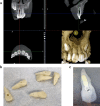Quality of different obturation techniques to fill perforating internal root resorption: a micro-computed tomographic study
- PMID: 38997675
- PMCID: PMC11245859
- DOI: 10.1186/s12903-024-04518-w
Quality of different obturation techniques to fill perforating internal root resorption: a micro-computed tomographic study
Abstract
Background: This study aimed to assess the quality of various obturation techniques to fill perforation caused by internal root resorption using Micro-computed Tomography.
Methods: Cone-beam computed tomography images of a maxillary central incisor tooth with perforating internal resorptive defect were used to create a 3D printed model of the affected tooth. The replicas were divided into four groups based on the obturation technique used. The techniques included Group 1: a polydimethylsiloxane-based sealer (GuttaFlow-2) with gutta-percha. Group 2: same as Group 1 except for using a pre-mixed Bioceramic-based sealer (NeoSEALER Flo). Group 3: the defect was filled entirely using the NeoSealer Flo Bioceramic-based sealer. Group 4: the samples were obturated using the warm vertical compaction technique with a resin-based sealer (ADSeal). The resin models were then scanned a micro-computed scanner to evaluate the percentage of voids in each group.
Results: The results showed that NeoSEALER Flo groups had significantly the highest volume of voids while GuttaFlow-2 and warm vertical compaction groups had the lowest void volume.
Conclusions: GuttaFlow-2 and warm vertical compaction techniques performed best in filling the internal resorptive defect.
Keywords: GuttaFlow-2; Internal Root Resorption; Micro-CT; NeoSealer Flo; Root canal Obturation; Root canal perforation.
© 2024. The Author(s).
Conflict of interest statement
The authors declare no competing interests.
Figures



Similar articles
-
Quality of obturation achieved by a non-gutta-percha-based root filling system in single-rooted canals.J Endod. 2014 Dec;40(12):2003-8. doi: 10.1016/j.joen.2014.07.032. Epub 2014 Sep 26. J Endod. 2014. PMID: 25262034
-
Evaluation of Different Techniques and Materials for Filling in 3-dimensional Printed Teeth Replicas with Perforating Internal Resorption by Means of Micro-Computed Tomography.J Endod. 2024 Feb;50(2):205-212. doi: 10.1016/j.joen.2023.10.014. Epub 2023 Oct 31. J Endod. 2024. PMID: 37918796
-
Quality of obturation achieved by an endodontic core-carrier system with crosslinked gutta-percha carrier in single-rooted canals.J Dent. 2014 Sep;42(9):1124-34. doi: 10.1016/j.jdent.2014.04.008. Epub 2014 Apr 24. J Dent. 2014. PMID: 24769108 Free PMC article.
-
Quality of different gutta-percha techniques when filling experimental internal resorptive cavities: a micro-computed tomography study.Aust Endod J. 2014 Dec;40(3):131-5. doi: 10.1111/aej.12043. Epub 2013 Oct 9. Aust Endod J. 2014. PMID: 24118357
-
Evaluation of root canal obturation: a three-dimensional in vitro study.J Endod. 2009 Apr;35(4):541-4. doi: 10.1016/j.joen.2008.12.021. Epub 2009 Feb 26. J Endod. 2009. PMID: 19345801
Cited by
-
Effect of indirect ultrasonic activation on the root canal obturation with premixed calcium silicate cement: an in vitro study.BMC Oral Health. 2025 Apr 15;25(1):570. doi: 10.1186/s12903-025-05748-2. BMC Oral Health. 2025. PMID: 40234919 Free PMC article.
-
Perforating Internal Root Resorption Sealed with Single-Cone Technique Using Bioceramic Sealer: A Case Report.Am J Case Rep. 2025 Jan 19;26:e946838. doi: 10.12659/AJCR.946838. Am J Case Rep. 2025. PMID: 39827364 Free PMC article.
References
MeSH terms
Substances
LinkOut - more resources
Full Text Sources

